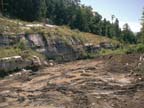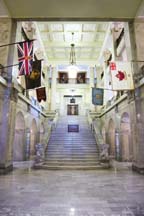
Throughout many major cities and towns of Canada and the U.S., there are many notable buildings -- including hospitals, churches and government buildings -- where the unique green and gray marbles of the Missisquoi quarry in Quebec, Canada, were widely utilized. However, a check of the construction dates for these buildings shows that none were constructed after 1960. That is because the quarry that produced this marble had ceased its operations. Now, 100 years after the first large-scale production of marble at the site, Polycor, the second largest and one of the most diversified suppliers of natural stone in North America, has reopened the quarries for full operation.
Obviously, some work needed to be done at the quarry -- which is located on the shores of Lake Champlain in Philipsburg, Quebec, about 35 miles southeast of Montreal -- for it to resume full-scale production. “The quarry was at the grass roots state,†said Jean-Nil Bouchard of Polycor. “Polycor did the complete production setting, the wood cutting and excavating of overburden and the full quarry development.â€
Surprisingly, now that the quarry is once again operational, the extraction methods are not much different than they were 40 years ago. “The quarry is similar to the old one,†said Bouchard. “The only changes are that today we utilize diamond wire instead of Helicoidal cable [for cutting], and we utilize a front end loader instead of an overhead crane [to remove blocks from the quarry site].â€

Quarrying history
The early history of the quarry was marred by instability in its ownership. The first large-scale production of marble in the Philipsburg area was begun in 1905 by Missisquoi Marble Co. After seven years, this company merged with the Lautz Marble Co. of Buffalo, NY, forming Missisquoi Lautz Corp., Ltd.Then in 1916, this partnership was dissolved, and all operations of the quarry were carried on under the name of Missisquoi Marble, Ltd. Unfortunately, this company went into liquidation in 1918, and the entire property and assets were purchased by Wallace Sandstone Quarries, Ltd., which would successfully operate the quarry for the next 42 years.
Wallace Sandstone Quarries Ltd. operated two marble quarries, from which the following five varieties of marble are obtained: Missisquoi Grey, Missisquoi Vert Gris, Missisquoi Regina, Missisquoi Rex and Missisquoi Black.
The first four varieties of marble were obtained from the main quarry, which was 700 feet long and 100 feet wide, and the black variety was obtained from a small quarry about 150 yards southeast of the main quarry. Vert Gris, Regina and Rex have different types of green veining with the same gray matrix. The Regina and the Rex were obtained from the same bed, but the Regina was a fleuri cut material and the Rex was a vein cut material.
During its existence, the Missisquoi quarry was operating the largest marble plant of its kind in Canada, and the only plant so equipped in all of Eastern Canada to process rough block into slabs and cut-to-size materials. But the quarry ultimately closed in 1960, and at that time, Missisquoi marble represented more than $8 million of yearly sales and employed about 300 employees.
The projects
Missisquoi marble was intensively used throughout Canada for more than 100 years. Hundreds of prestigious projects were supplied by the previous owner, including seven Canadian Parliament Buildings. The largest concentration of projects is in Ottawa, where most of the Federal buildings used this popular marble for rotundas, entrances, stairways and corridors (walls and floors).The Parliament Building in Ottawa features some of the most extensive use of Missisquoi marble. The floors of the corridors, entrance halls and stairs of the facility all feature Missisquoi Grey marble, while the walls of the corridors of the fourth and fifth floors are clad in Missisquoi Vert Gris marble. Missisquoi Black marble is used as a border and base on the floors of main corridors. Meanwhile, the Supreme Court Building in Ottawa makes stunning use of Missisquoi marble on the floors and walls, encircling the building on the ground floor and first and second floors.
The stone was also used further west in Canada for the Parliament Building in Edmonton, Alberta. For this facility, much of the stone use is in the rotunda. Missisquoi Mottled Grey marble was used on the floors and pedestals of the Grand Staircase, while Missisquoi Light Grey marble covers the walls of the rotunda and corridors. Missisquoi Regina marble and Vert Rose marble (green marble that enclose veins and lenses of white to pink calcite) were also used for columns and borders in that space.
“We are very pleased to be bringing the Missisquoi marble quarry back to life,†said Bouchard. “We expect to see Missisquoi marble regain its great stature, but this time in buildings worldwide.â€
